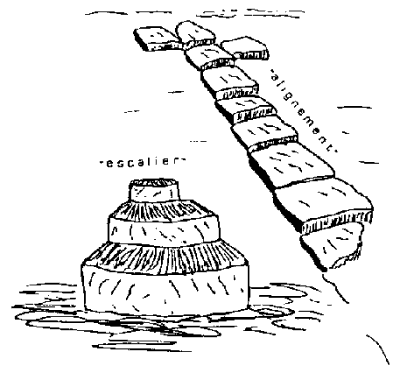 |
Science Frontiers ONLINE No. 58: Jul-Aug 1988 |
|
|
Lanzarote: un noveau bimini?
Yes, we are drawing on the Frenchlanguage journals again; this timme from Kadath, an archeological publication from Belgium. The reason, of course, is that the mainstream English-language archeological journals are notoriously conservative and, well, mainstreamish!
The catchword in the title is "Bimini," a word which loses nothing in translation, for it is well-known in that States as one of the Bahamian resort islands. It was in the waters off Bimini that divers found the famous Bimini "road" or "wall," which some maintain is constructed of human-sculpted stone blocks. (See our handbook Ancient Man.)
Lanzarote, on the other hand, is one of the Canary Islands. Here, too, one finds a submerged, Bimini-like row of apparently man-made blocks of stones. Some 22 meters down, the blocks are arranged in a sort of staircase, as shown in the figure. The steps, however, are 40-cm high, too big a step for humans. Is this structure a submerged pier, an altar, or something else. No one knows. Possibly relevant is a statuette, stylistically Olmec, which was also found in Lanzarote waters. (Bajocco, Alf; "Lanzarote: un Nouveau Bimini?" Kadath, no. 66, p. 6, Winter 1987.)
Comment. The name, Kadath, incidentally comes from the writings of H.P. Lovecraft, a mostly forgotten, highly imaginative American writer. Kadath was Lovecrafts' great city of the ancients. Reference. Ancient Man, mentioned above, is described here.
 |
Alignments of blocks in 22 meteres of water off Lanzarote. (Left) Front view showing stepped arrangement. |